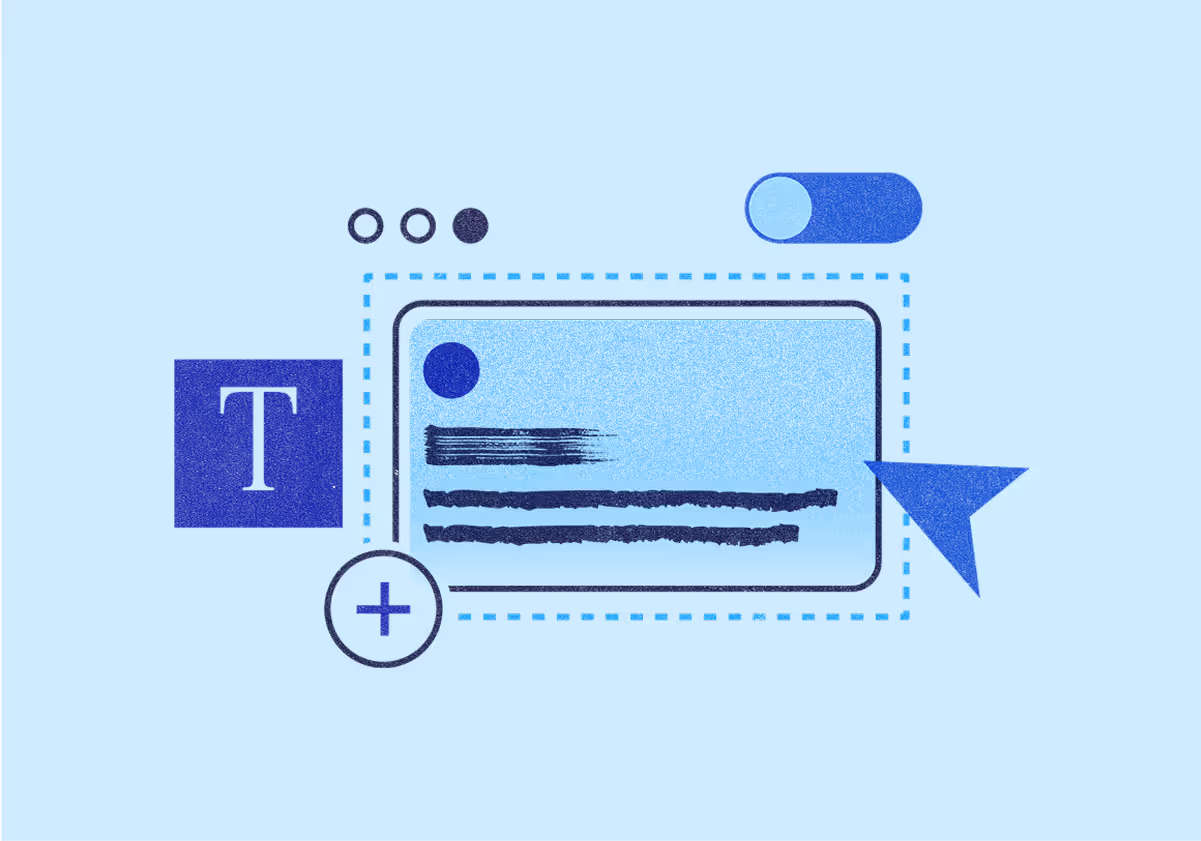Jasper Marketing
November 13, 2024
Best AI Use Cases For Retail Marketers
Retailers are finding innovative ways to navigate a complex landscape and tap into AI's potential in retail.

Smart retail marketers know they need to get ahead of the curve when it comes to digital transformation—because artificial intelligence (AI) has entered the retail landscape (and it's about to reshape the entire industry.)
McKinsey data predicts AI will unlock a staggering $240 billion to $390 billion in economic value for retailers, transforming everything from how we shop as consumers to how retailers manage their operations. As a result, retailers are finding innovative ways to navigate this complex landscape and tap into AI's potential in retail.

But how do consumers want to see AI used in retail? Data from a Future Commerce report emphasizes three main areas: consumer empowerment, context, and simpler payment methods.

Retailers who find innovative ways to tap into this earn a real advantage via AI. Thanks to modern tech, it’s becoming easier than ever.
AI Use Cases for Retail
The use cases for AI in retail are growing by the minute. “Last year, our Connected Shoppers' report showed that 17% of shoppers used Gen AI for product inspiration. 14% of them were very interested in using it for beauty recommendations. Now shoppers are showing how to use ChatGPT to get skincare recommendations,” said Michelle Grant, Insights & Strategy at Salesforce. Let’s look at a few in more retail use cases for AI in detail.
Virtual and Digital Assistants
Virtual shopping assistants are revolutionizing how we shop. These AI-powered helpers act like your personal shopping assistants who know exactly what you're looking for. What’s most impressive: they’re uncannily good at making product recommendations based on data from browsing history, past purchases, and style preferences.
Take Nike's digital assistant as an example in the online shopping environment. It suggests the perfect running shoes based on your training habits and helps you find the right size by analyzing your previous purchases and fit feedback. Similarly, Sephora's Virtual Artist, which is AI-powered, does an incredible job recommending makeup products that match your skin tone and preferences.
These digital companions are equally helpful for in-store shopping. Lowe's Innovation Labs introduced LoweBot, which uses AI to guide customers through their massive stores, pointing them directly to the drill bit or paint color they're after. These digital companions are equally helpful for in-store shopping. Lowe's Innovation Labs introduced LoweBot, which uses AI to guide customers through their massive stores, pointing them directly to the drill bit or paint color they're after.

These digital companions are equally helpful for in-store shopping. Lowe's Innovation Labs introduced LoweBot, which uses AI to guide customers through their massive stores, pointing them directly to the drill bit or paint color they're after.

Believe it or not, these shopping assistants can even instantly check if items are in stock and suggest alternatives if they're not, further removing friction from the shopping experience.
Content Production at Scale
AI is rapidly changing how retail marketers handle content creation. It’s now possible to create quality content at scale while maintaining your brand voice and relevance.
With tools like Jasper, you can quickly generate compelling headlines, spotlight product benefits, and calls to action that speak directly to your target audience with simple prompts like: "Write five headline variations for our summer collection landing page targeting millennial fashion shoppers."
Product descriptions become a breeze too. Retail marketing teams can use AI to generate engaging copy that highlights key features and benefits. A simple prompt like "Write a product description for a lightweight running shoe, emphasizing breathability and comfort" provides a great starting point for your copywriting efforts.
Managing social media across different regions? AI can help plan your content calendars by suggesting localized post ideas. It can even adapt content for different markets. Try "Create a month's worth of Instagram posts for our sustainable fashion line, adapted for US and UK audiences."
As for blogs and articles, AI excels at creating SEO-optimized content with relevant market trends. It analyzes top-ranking content for your target keywords to identify an optimal content structure, helps maintain ideal keyword density without overstuffing and creates SEO-friendly meta descriptions and title tags.
Try this prompt: "Analyze current sustainable fashion trends and write a data-driven blog post that includes:
- 3 emerging consumer behavior patterns
- 2 key market statistics
- Impact on retail strategy
- Future predictions

How Adidas uses Jasper for success in B2B
Enhanced Customer Support Using Chatbots
Remember the frustration of waiting until business hours started to be able to track a package or ask about a return? Those days are long gone. Today's AI chatbots are like having an always-on retail assistant ready to help in whatever language you prefer.
Take H&M’s chatbot for example. It can do everything from helping you track that package you're anxiously waiting for to suggesting the perfect outfit for your next date night.

But here's where it gets really interesting: these bots don't just sit around waiting for questions. When Sephora saw shoppers abandoning their carts, their chatbot started reaching out with friendly reminders and personalized offers. The result? A whopping 32% drop in abandoned carts.
The numbers don't lie—retailers using this tech are seeing their customer service costs drop by 30% while improving the overall customer experience.
Image Generation for Marketing Creatives
Visual AI is reshaping how retailers create and personalize marketing content. One of the most exciting applications is virtual try-on technology, which lets shoppers visualize clothes on themselves before buying.
H&M recently launched a "H&M Try On" feature, while ASOS's "See My Fit" shows clothes on models of different sizes, helping customers make more confident online purchases.

Need to generate consistent product lifestyle images across multiple settings? Ensure your brand visuals for marketing campaigns are cohesive? AI-powered tools are game changers for retail marketing teams when it comes to image generation for campaigns and content with specialized features built for ecommerce and retail.
Jasper’s AI image suite lets you quickly produce variations of product photos with different backgrounds, lighting conditions, and styling options so you can work more efficiently and reduce production costs at scale.

The next frontier? AI that can generate personalized lifestyle images featuring products in settings that resonate with individual customers' preferences and lifestyles.
A/B Testing Marketing Campaigns
AI-powered A/B testing has revolutionized how retail marketers optimize their real-time campaigns.
"We used to make educated guesses about what would resonate with our customers. Now, AI gives us concrete data to make decisions within hours, not weeks," said Sarah Chen, Digital Marketing Director at Urban Outfitters.
Modern AI tools track crucial metrics like conversion rates, click-through rates, and engagement patterns as they happen. This real-time analysis allows marketers to quickly pivot when something isn't working or double down on successful elements.
Tools like Jasper can generate multiple versions of ad copy, email subject lines, and social media posts, each tailored to different customer segments. These variations can be tested simultaneously, with AI automatically identifying which versions drive the best results.

For instance, when testing email campaigns, you may discover emails with emoji-filled subject lines perform better with Gen Z customers, while straightforward benefit-focused headlines resonate more Gen Alpha and Baby Boomer demographics.
As LLMs continue to collect and analyze data, it becomes increasingly accurate at predicting which content variations will perform best for specific audience segments.
The Future of AI Use Cases for Retail
The retail landscape is in for some mind-blowing changes, thanks to AI. Think of retail's future as your own personal shopping wonderland, where every store visit feels like it was tailor-made just for you.
Here are some additional key AI innovations reshaping retail:
- Smart algorithms creating hyper-personalized shopping experiences
- Virtual try-ons for more accurate size/fit context pre-purchase
- Smart mirrors functioning as personal stylists
- Predictive inventory management to prevent stockouts
Behind the scenes, AI will be the retail industry's secret sauce, predicting inventory needs with incredible accuracy and spotting shopping trends before they even take off. The best part? All this tech will make shopping more human, not less. Store employees will be freed from rote tasks to focus on what they do best: providing that personal touch and expert advice when needed.
AI Use Cases for Retail: Looking Forward
From managing inventory across multiple channels to delivering the personalized experiences customers expect, AI use cases for retail abound. It's no longer about replacing human creativity but enhancing it (and allowing marketing teams to focus on strategy while AI handles the heavy lifting of execution.) For retail marketers ready to embrace the future, AI isn't just an option; it's the key to staying ahead in an increasingly competitive landscape.
Want more? Dive into this webinar with practical applications of AI in the retail sector, guided by real-world examples from Adidas.
More of the latest & greatest

Gemini 3 Pro in 24 Hours: Inside Jasper’s LLM-Optimized Architecture
How does Jasper validate new AI models like Gemini 3 Pro in under 24 hours? Inside our rigorous 3-step testing process for enterprise marketing.
December 4, 2025
|
Nick Hough

3 Predictions for AI in Marketing in 2026
In 2026, AI will rewire teams, streamline tooling, and turn content into a competitive engine.
December 2, 2025
|
Loreal Lynch
.png)
Highlights from Jasper Assembly: Scaling Content with Confidence
Discover key insights from Jasper Assembly 2025. Leaders from Sanofi, NetApp, U.S. Bank, and BCG shared AI marketing strategies for scaling content and driving impact.
November 19, 2025
|
Loreal Lynch













